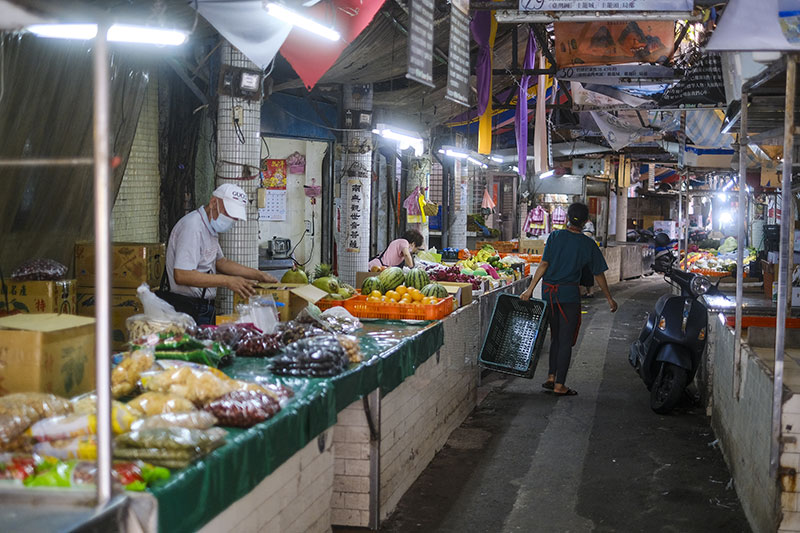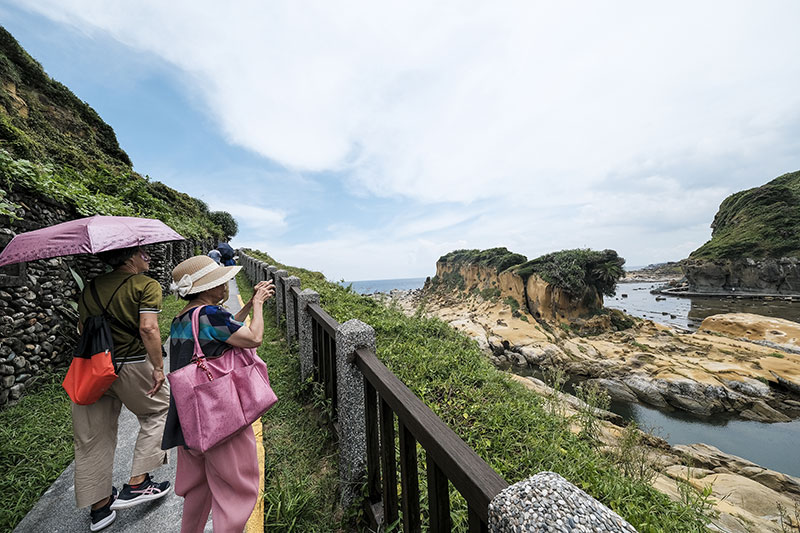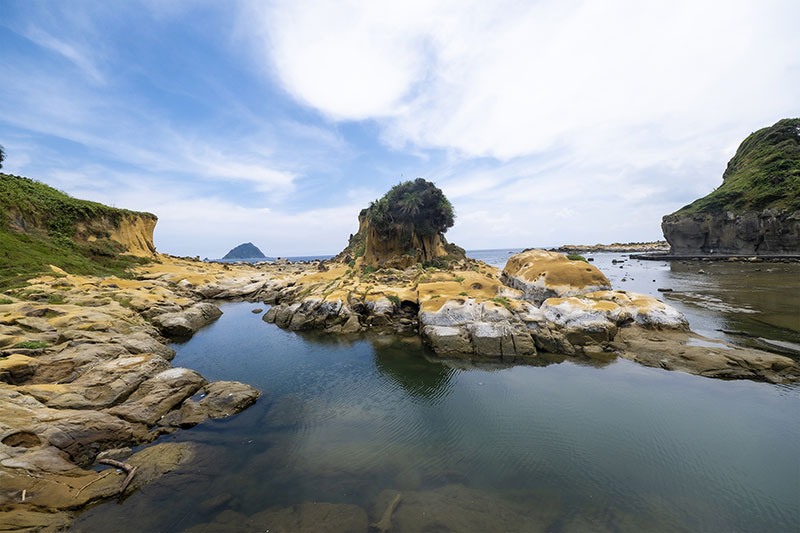
As a proud local, Tsao Ming-chung talks about the past and present of Heping Island with great gusto.
Heping Bridge in Northern Taiwan’s Keelung City straddles the narrow Bachimen Channel, providing access to the islet that lies nearest the main island of Taiwan. The distance is less than 100 meters.
You would think that Heping Island was entirely cut off from the civilized world before the bridge was built. But far from representing an insurmountable barrier, the surrounding sea actually enabled the island’s transformation into a bustling base of operations during the Age of Sail.

The site of today’s Heping Island Market is where the island’s first Han Chinese immigrants settled.
Heping Island bears traces of early development. “Historical documents in Chinese and in Western languages suggest that Heping Island is where the history of Northern Taiwan began,” says Tsao Ming-chung, a writer and cultural historian. The era of Spanish colonization, lasting from 1626 to 1642, is especially noteworthy.
Short though it was, the 16-year period saw the Spanish using Heping Island as a springboard to occupy Northern Taiwan in a bid to rival Dutch colonial ambitions in the Far East. In the wake of the indigenous Basai people, and the later Chinese immigrants who settled there because of the convenient location, the arrival of the Spanish marked the first time a colonial power had put its stamp on Heping Island. This was when the island, standing for Keelung as a whole, made its debut on the global stage.
In turn, the Dutch, the Filipinos, the French, the Japanese, the Ryukyuans, and the Koreans all followed in the footsteps of the Spanish colonists and arrived on the scene. It’s hard to imagine that this tranquil place used to be a vibrant center of activity.
Heping Island’s early history remained buried in oblivion until Spanish historian José Eugenio Borao Mateo initiated a research project on the history of Spain’s colonial presence in Taiwan.
Ang Kaim, a former associate research fellow in the Institute of Taiwan History, Academia Sinica, is a specialist in 17th-century Taiwanese history, and is well versed in Taiwanese Hokkien, Japanese, Spanish, and Old Dutch. As if following the lead of Borao Mateo, he has been attempting to use phonetics and onomastics to tease out evidence for Spain’s activities in Taiwan.
For example, Ang speculates that Sandiaojiao in New Taipei’s Gongliao District may have derived its name from “Santiago,” a sobriquet that Spanish seafarers came up with when they sailed past this cape on Taiwan’s Northeast Coast. Similarly, Yeliu in New Taipei’s Wanli District may owe its name to the Spanish phrase “Punta Diablos” (the Devil’s cape), which recalls the dangerous reefs that the Spanish mariners had to negotiate there, as well as possible attacks from the indigenous people onshore.
Ang is a long-term collaborator of Tsao Ming-chung. Together, they have worked on several history books intended for the general public. A local in Keelung who lives within walking distance of Heping Island, Tsao has applied himself to conducting field research there.
Ever enthusiastic about local history, Tsao has synthesized historical anecdotes, legends, and documentary evidence, filtering these materials through his own imagination to write Hermosa, a historical novel that offers a vivid portrait of Heping Island.
What does “Hermosa” mean? “The Portuguese and the Dutch called Taiwan ‘Ilha Formosa,’ but the Spanish name was ‘Isla Hermosa,’” Tsao explains. Both names mean “beautiful island.” To achieve a greater understanding of Heping Island’s past and present, we must not neglect this tumultuous era of “Hermosa.”

Fanzi Cave is located within Heping Island Geopark.
Turbulent history
Tsao Ming-chung takes us on a tour of Heping Island. Having driven across Heping Bridge, we pull over on “Seafood Street” (Lane 2 of Heyi Street), near the harbor. We get out and loiter near the bridge, looking at the distant shore across the Bachimen Channel. There, adjacent to the newly constructed Sheliao Bridge and the long seawall, is the public housing that features in this year’s popular TV drama Port of Lies.
Back on the island, in the vicinity of the bridge, we notice the local Fude Temple, dedicated to the Earth God. Tsao says that the temple square used to be part of the wharf during the Qing Dynasty.
Close to this side of Seafood Street is where the small cubical tower of San Luis, built by the Spanish, once stood. The Dutch, who arrived in Northern Taiwan after the Spanish, also realized the strategic importance of this site and continued to develop it, renaming it Eltenburgh.
Pointing at the nearby shoreline, Tsao retraces the Spanish–Dutch conflict here. In 1642 the Dutch colonists, fearing Spanish dominance, set out for Heping Island from their headquarters in Fort Zeelandia in Southern Taiwan and landed at the other end of the narrow channel here, out of range of the Spanish artillery. This was the first international warfare in Taiwanese history. The Dutch won, and the Spanish had to clear out of Heping Island.

Visitors admire the extraordinary landforms along the coastal path.
Todos los Santos
Time has swept away the 17th-century battlefield, but we can still conjure up images of that bygone era if we visit the southern part of Heping Island, where architectural relics left by the Spanish have been preserved.
This southern region witnessed the island’s earliest human settlements. Researchers have suggested that the site of today’s Heping Island Market is where the earliest Han Chinese immigrants in Keelung lived; a total of seven or eight households settled here. As Keelung is within a relatively short distance of Fuzhou across the Taiwan Strait, it is reasonable to suppose that these Chinese settlers came from that area of Fujian Province.
Located near the market, the remains of the Dominican church of Todos los Santos also carry great historical significance. Tsao says that the Spanish name, which means “all saints,” stems from the Catholic tradition of venerating saints. In addition to canonized religious figures, the church commemorated those otherwise unremembered souls who devoted themselves to their faith or even died for it.
The ruins of the church lay under a car park belonging to Taiwan’s CSBC Corporation. We owe their discovery to an archeological project begun in 2011 and led by Spanish archeologist María Cruz Berrocal and Academia Sinica research fellow Tsang Cheng-hwa. It was Borao Mateo who helped bring together the international team.
At the excavation site today, we can see the remaining gray foundations of Todos los Santos. The archeologists have unearthed various objects here, including a cross and a belt buckle. They have also discovered a burial ground behind the church. Of the 20-odd individuals buried here, some appeared to be in an attitude of prayer, with their hands clasped upon their chests. It has been ascertained that several of the people buried were Europeans.
The archeological finds at Todos los Santos have not only helped substantiate that transient period of Taiwanese history, but also transformed the site into a major tourist attraction.

Heping Island promises vivid glimpses of the era of Hermosa.
Heping Island Geopark
Our trip culminates with a visit to Heping Island Geopark. Located in the northern part of the island, it embraces the bay of Alapawan. CSBC Corporation’s Keelung shipyard is visible from its entrance. “Fort San Salvador is right under the shipyard,” says Tsao, pointing at the gigantic crane that dominates the distant view.
The Spanish fort has not survived the ravages of time, but we can still marvel at the wonders of nature as we meander along the coastal path, allowing our imaginations to run wild among the phantasmagorical rocks scattered on the edge of the sea.
The scenery here furnishes the most important setting in Hermosa. Although visitors today can only catch a glimpse of the spectacular masses of rocks from a distance, Tsao’s novel vividly evokes erstwhile scenes of people fishing and enjoying themselves in this landscape.
A large sandstone landform here contains a sea cave called Fanzidong (“cave of foreign words”). Though the names and dates carved inside the cave are barely legible now, Ang Kaim draws our attention to a photograph in Japanese anthropologist Kanori Ino’s Chronicles of Taiwan Culture (1928) which shows an abundance of clear marks left here by 17th-century Dutch soldiers, as well as by Europeans and Americans who visited in the latter half of the 19th century.
Listed as one of Keelung’s historic sites, Fanzidong is under protection and no longer open to the public. In Hermosa, nevertheless, Tsao presents a tantalizing picture of the cave, where his protagonists pledge their love to each other.
Our very last stop on Heping Island is Love Pin, a café on the third floor of the visitor center at Heping Island Geopark. Here we cast our minds back over scenes from Hermosa while savoring foods prepared with local algae such as sea grapes (Caulerpa lentillifera), and flying-fish roe, along with cross-shaped biscuits that emit the soft fragrance of dried seaweed, being made with locally harvested sea lettuce.
Tsao’s novel relies on scholarly evidence for its fabulously rich texture, underpinning fiction with fact. Sitting next to the window, with the sea outside, we’re able to visualize the world of Tsao’s protagonists and imagine lilies blooming on the hills in spring, flying fish sporting over the waves in early summer, algae freshly gathered from the sea by the Basai indigenous people, and crucifix crabs (Charybdis feriata) bearing cross marks on their shells—supposedly a blessing of St. Francis Xavier, a Spanish missionary who cofounded the Society of Jesus.
These things, which may seem unremarkable at first glance, actually reveal the unique character of this small island, a place that carries memories of the encounters of people from diverse ethnic, social, and cultural backgrounds. Tsao concludes that “the history of Heping Island represents the history of Keelung, and the history of Taiwan itself.” Small as it is, Heping Island, with its profound historical significance, deserves to be appreciated and cherished by all.
For more pictures, please click 《Imagining the Era of Hermosa: A Tour of Heping Island》
Related Links
Tracing the Spanish Presence in Taiwan: The Archaeology of Heping Island











